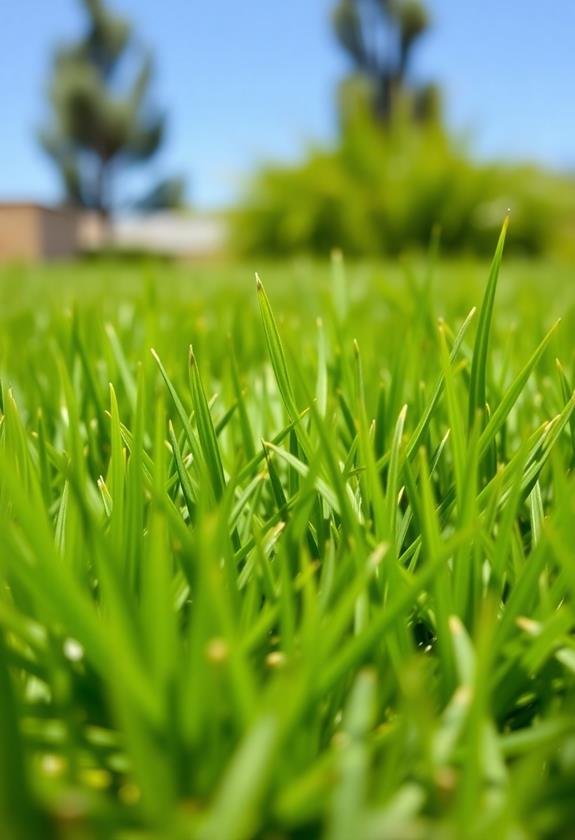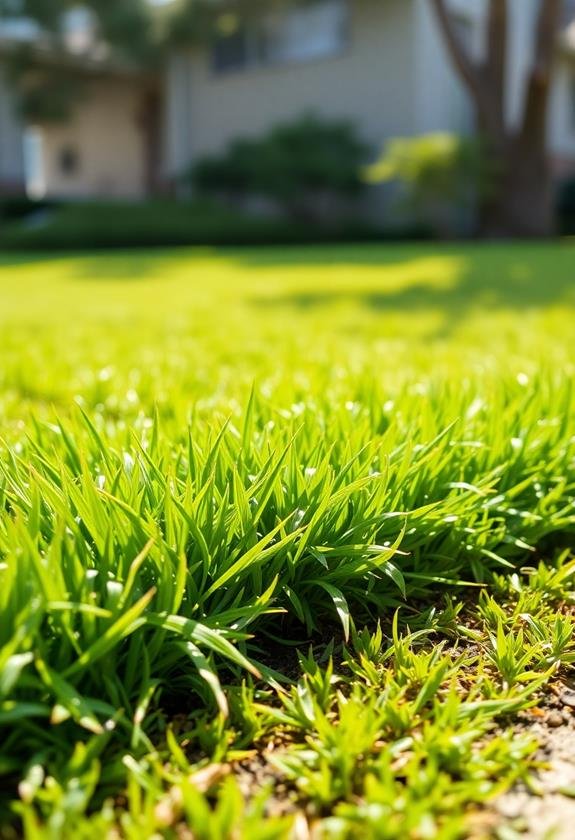Looking for drought-resistant grass seeds? You’re in luck! Several hardy varieties can keep your lawn lush even when the rain’s scarce. Bermuda grass, with its deep roots and quick recovery, is a top choice for scorching summers. Buffalo grass, a native North American species, thrives in heat and needs minimal maintenance. Zoysia grass is another water-wise option that tolerates foot traffic well. Don’t overlook tall fescue, bahiagrass, fine fescue, or St. Augustine grass, either – each has unique drought-tolerant qualities. Remember, the best choice depends on your specific climate and soil conditions. Stick around to uncover the perfect grass seed for your drought-prone yard!
Key Takeaways
- Bermuda Grass is highly resilient in drought-prone areas with a deep root system and quick recovery after dry spells.
- Buffalo Grass is native to North America, requires minimal water, and thrives in temperatures up to 95°F.
- Zoysia Grass needs 50% less water than many grass types and retains its green color during dry periods.
- Tall Fescue adapts to various soil conditions and has a deep root system reaching 2-3 feet for accessing water.
- Bahiagrass is low maintenance, naturally pest-resistant, and adapts well to various soil types, including sandy and acidic soils.
Bermuda Grass

Bermuda grass’s resilience makes it a top choice for drought-prone areas. If you’re looking for a lawn that can withstand scorching summers and minimal rainfall, this warm-season grass might be your perfect match. I’ve seen Bermuda grass thrive in my aunt’s yard, even during the driest months!
Here’s why Bermuda grass is a drought-resistant superstar:
- Deep root system: It can reach up to 6 feet deep, accessing water sources other grasses can’t.
- Quick recovery: After periods of drought, it bounces back faster than you can say “rain dance.”
- Low water requirements: Once established, it needs 20% less water than cool-season grasses.
To get the most out of your Bermuda grass:
- Plant in full sun for best results
- Mow regularly to encourage dense growth
- Fertilize during active growing season
Keep in mind, Bermuda grass can be invasive, so you might need to keep an eye on its borders.
But don’t let that deter you – its ability to create a lush, green carpet even in the driest conditions is worth the extra effort. Trust me, your neighbors will be green with envy!
Buffalo Grass
While Bermuda grass thrives in hot, dry conditions, it’s not the only drought-resistant option for your lawn. Buffalo grass, a native North American species, is another excellent choice for water-conscious gardeners.
I’ve personally found this grass to be a real game-changer in my xeriscape designs!
Buffalo grass boasts some impressive qualities:
- Low maintenance: It only needs mowing once or twice a year
- Excellent heat tolerance: Thrives in temperatures up to 95°F
- Deep root system: Reaches up to 6 feet, accessing water deep in the soil
You’ll love how this grass forms a dense, blue-green turf that feels soft underfoot. It’s perfect for those lazy summer afternoons when you want to picnic in your backyard!
However, keep in mind that buffalo grass prefers full sun and well-drained soil.
To establish buffalo grass:
- Sow seeds in late spring or early summer
- Water regularly for the first few weeks
- Reduce watering gradually as the grass establishes
Pro tip: Mix buffalo grass with other native wildflowers for a charming, prairie-like look. Trust me, your neighbors will be green with envy!
Zoysia Grass

Zoysia’s reputation as a drought-resistant grass is well-deserved. This warm-season grass is a champion when it comes to water conservation, and I’ve seen it thrive in my own yard during scorching summers. You’ll love how it forms a dense, carpet-like turf that’s both beautiful and resilient.
Here’s why Zoysia might be your new favorite lawn grass:
- Water-wise: It needs 50% less water than many other grass types.
- Slow-growing: Less mowing for you!
- Tolerates foot traffic: Perfect for active families.
When I first planted Zoysia, I was amazed at how quickly it established itself. Within weeks, I’d a lush, green lawn that was the envy of the neighborhood.
But here’s the kicker – it stayed green even when my neighbors’ lawns turned brown during a dry spell.
Pro tip: For best results, plant Zoysia in spring or early summer. It loves full sun but can tolerate partial shade.
Just remember, it’s a slow spreader, so patience is key. Trust me, the wait is worth it for a lawn that’s both drought-resistant and gorgeous!
Tall Fescue
Tall Fescue, a cool-season powerhouse, stands out as another excellent choice for drought-resistant lawns. You’ll love its deep root system, which can reach up to 2-3 feet underground, allowing it to access water sources other grasses can’t reach.
This hardy grass type thrives in various soil conditions and can handle both heat and cold, making it perfect for regions with unpredictable weather patterns.
I remember when I first planted Tall Fescue in my backyard – it was a game-changer! Here are some key benefits you’ll enjoy:
- Exceptional drought tolerance
- Ability to stay green year-round in many climates
- Low maintenance requirements
When planting Tall Fescue, keep these tips in mind:
- Sow seeds in early fall or spring for best results
- Maintain a mowing height of 3-4 inches to promote deeper roots
- Water deeply but infrequently to encourage drought resistance
While it’s not the fastest-growing grass out there (trust me, I’ve watched grass grow!), Tall Fescue’s durability more than makes up for it.
You’ll find yourself spending less time watering and more time enjoying your lush, green lawn.
Bahiagrass

Bahiagrass, a warm-season warrior, excels in drought-prone areas with its deep root system and exceptional heat tolerance. You’ll love how this grass stands up to scorching temperatures and minimal rainfall.
I’ve seen Bahiagrass thrive in my uncle’s Florida lawn, where other grasses wilt under the relentless sun.
Here’s why you might choose Bahiagrass for your drought-prone yard:
- Low maintenance: It requires less fertilizer and water than other grass types.
- Pest resistance: It’s naturally resistant to many common lawn pests.
- Versatility: It adapts well to various soil types, including sandy and acidic soils.
When planting Bahiagrass, remember:
- Sow seeds in late spring or early summer when soil temperatures reach 70°F.
- Keep the soil moist until germination, which typically takes 14-28 days.
- Once established, reduce watering to encourage deep root growth.
While Bahiagrass isn’t the most visually striking grass (it’s a bit coarse), its practicality in drought-prone areas is undeniable.
Trust me, when your neighbor’s lawn is brown and crunchy, you’ll be the envy of the block with your lush, green Bahiagrass!
Fine Fescue
Shifting our focus from warm-season grasses, let’s explore Fine Fescue, a cool-season option that’s equally impressive in drought-prone areas.
This versatile grass type is perfect for those of you living in cooler climates who still want a lawn that can withstand dry spells. I’ve used Fine Fescue in my own yard, and I’m always amazed at how well it holds up during our notoriously dry summers.
Fine Fescue offers several advantages:
- Low maintenance requirements
- Excellent shade tolerance
- Fine texture that creates a lush, carpet-like appearance
When planting Fine Fescue, you’ll want to aim for the cooler months of spring or fall.
Trust me, I learned this the hard way after a failed summer planting attempt! The key is to keep the soil moist during germination, which typically takes about 10-14 days.
Once established, you’ll find that Fine Fescue requires less water than many other grass types.
St. Augustine Grass

A favorite among homeowners in warm, coastal regions, St. Augustine grass is a top choice for drought-resistant lawns.
You’ll love its lush, carpet-like appearance and ability to thrive in hot, humid climates. I remember the first time I saw a St. Augustine lawn in Florida – it was like walking on a green cloud!
Here’s why you might want to contemplate St. Augustine for your yard:
- Excellent shade tolerance
- Salt-resistant (perfect for coastal areas)
- Forms a dense, weed-choking turf
While it’s not typically grown from seed, you can easily establish St. Augustine using sod or plugs.
Once it takes root, you’ll be amazed at how quickly it spreads. Just be prepared for some maintenance:
- Mow regularly to keep it at 2.5-4 inches
- Water deeply but infrequently
- Apply a slow-release fertilizer in spring and summer
One downside? St. Augustine isn’t the most foot-traffic friendly grass.
But if you’re looking for a beautiful, low-maintenance lawn that can handle drought and heat, it’s hard to beat. Trust me, your neighbors will be green with envy!
Frequently Asked Questions
How Long Does It Take for Drought-Resistant Grass to Establish?
Drought-resistant grass generally grows gradually, giving you a gentle glimpse of green glory.
You’ll see sprouts within 7-14 days, but full establishment can take 3-4 months. It’s a patient process, but worth the wait!
I’ve found that proper watering during the first few weeks is essential. Remember, even drought-resistant varieties need TLC initially.
Once established, though, you’ll have a tough, thirsty-less lawn that’ll be the envy of your neighbors.
Keep an eye out for that first mow milestone!
Can Drought-Resistant Grass Survive in Areas With Frequent Frost?
You’ll be pleased to know that many drought-resistant grasses can indeed survive in frosty areas!
While they’re tough cookies, you’ll want to choose varieties suited to your specific climate. Cool-season grasses like fescues and ryegrasses are your best bet.
They’ve got a knack for handling both dry spells and chilly temps. Just remember, even these hardy types might need a little extra TLC during extreme cold snaps.
I’ve had great success with tall fescue in my own frost-prone garden!
Are Drought-Resistant Grasses Suitable for High-Traffic Areas?
You bet your Walkman that drought-resistant grasses can handle high-traffic areas! They’re tough cookies, designed to withstand stress.
However, you’ll want to choose wisely. Some varieties, like Bermuda or Zoysia, are real troopers in busy spots. They’ve got deep roots and bounce back quickly. I’ve seen my neighbor’s Bermuda lawn survive endless soccer games!
Do Drought-Resistant Grasses Require Different Mowing Techniques?
When it comes to mowing drought-resistant grasses, you’ll want to adjust your techniques a bit.
First, raise your mower blade higher – about 3-4 inches is ideal. This helps protect the grass’s root system and retain moisture.
You’ll also want to mow less frequently, as these grasses grow slower. Remember, never cut more than 1/3 of the blade length at once.
I’ve found that mowing in the early morning or late evening helps reduce stress on the grass, too.
Can Drought-Resistant Grass Seeds Be Mixed With Other Grass Types?
Like blending different spices to create a perfect dish, you can mix drought-resistant grass seeds with other types. It’s a great way to create a diverse, resilient lawn.
I’ve had success combining fescue with Kentucky bluegrass in my yard. You’ll want to take into account your climate, soil type, and desired look.




